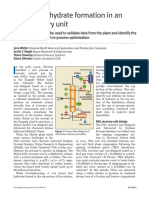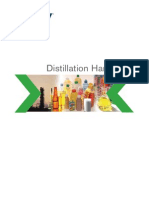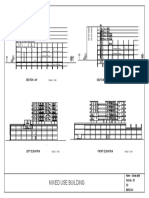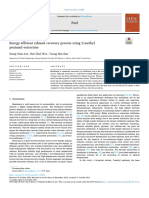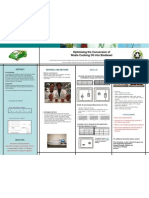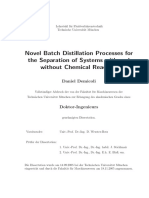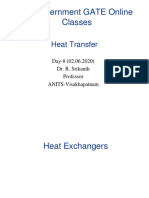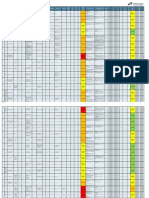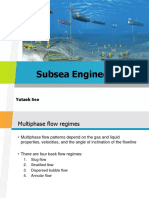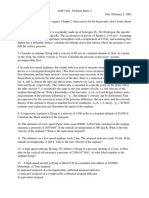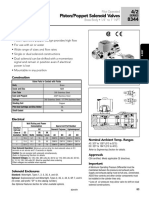Distillation Rectification: Basic Knowledge Basic Knowledge
Distillation Rectification: Basic Knowledge Basic Knowledge
Uploaded by
Rohan lallCopyright:
Available Formats
Distillation Rectification: Basic Knowledge Basic Knowledge
Distillation Rectification: Basic Knowledge Basic Knowledge
Uploaded by
Rohan lallOriginal Description:
Original Title
Copyright
Available Formats
Share this document
Did you find this document useful?
Is this content inappropriate?
Copyright:
Available Formats
Distillation Rectification: Basic Knowledge Basic Knowledge
Distillation Rectification: Basic Knowledge Basic Knowledge
Uploaded by
Rohan lallCopyright:
Available Formats
4 Thermal process engineering
Distillation/Rectification
gunt
Basic knowledge Basic knowledge
Distillation Rectification
Distillation is a unit operation that can be used to separate into the gas phase. Examples of volatile liquids include acetone, Rectification is an application of distillation. It is used for sub- In practice, this multi-stage distillation process is carried out
homogeneous liquid mixtures. It utilises the different volatility of alcohol and petrol. stances that are required in high purity and/or large quantities, in the form of countercurrent distillation (rectification) in a
the components of the mixture to be separated. Volatility refers for example to fractionate crude oil. column.
to the tendency of a substance to pass from the liquid phase
If the distillate obtained during distillation is distilled again, a
new distillate is obtained with an even higher concentration of
volatile components. As the procedure is repeated, the concen-
tration of volatile components in the distillate increases on each
occasion.
Principle of distillation Simplified illustration of a rectification column
7
6
3
10 9
8
2
11
1 4
The liquid mixture to be separated (feed) is fed to the col-
umn and partially evaporates on its way to the bottom of the
column where it is heated to boiling. The vapour produced
1 moves upwards inside the column, exits it at the top and is
condensed. Part of the condensate is carried away as top
product. The remainder flows back into the column and moves
5 downwards as liquid phase.
Due to column internals, such as bubble cap trays or ran-
dom packings, the downward-moving liquid phase is sub-
jected to an intensive exchange of heat and material with the
upward-moving vapour phase. The less volatile components
1 boiling liquid mixture, 2 upward-moving vapour phase, of the vapour phase condense and increase in concentration
3 condenser, 4 distillate in the liquid phase. At the same time, the condensation heat
released evaporates the more volatile components of the liq-
uid phase. These processes in the column increase the vapour
To achieve separation, the liquid mixture is brought to boil- The separating principle is based on the fact that the content phase concentration of volatile components moving from the
ing point. The resulting vapour phase is made up of several of volatile components is greater in the vapour phase than in bottom to the top of the column. The liquid phase concen-
components, mainly the more volatile components of the mix- the liquid phase. 3 tration of less volatile components increases in the opposite
ture. The vapour phase is separated from the liquid phase and direction, from the top of the column to the bottom.
condensed (distillate). The less volatile components predomi- 2
4
nantly remain in the liquid phase.
Distillation does not result in complete separation of the liq-
uid mixture, but rather its division into two mixtures with 1 feed, 2 bottom of column, 3 bottom heating, 4 bottom product, 5 upward-moving vapour phase, 6 top of column, 7 condenser,
different contents of volatile and less volatile components. 8 top product, 9 reflux, 10 downward-moving liquid phase, 11 tray (here: bubble cap tray)
294 295
You might also like
- Differentiated Reading for Comprehension, Grade 6From EverandDifferentiated Reading for Comprehension, Grade 6Rating: 5 out of 5 stars5/5 (2)
- Sandpiper Service Operation ManualDocument21 pagesSandpiper Service Operation ManualJefril SiruNo ratings yet
- 51 Parex ProcessDocument2 pages51 Parex Processbengris100% (2)
- New Microsoft Word DocumentDocument8 pagesNew Microsoft Word Documentnis123bochareNo ratings yet
- Simple and Fractional Distillation Repaired)Document4 pagesSimple and Fractional Distillation Repaired)Janine LauretaNo ratings yet
- Chapter 2 DistillationDocument77 pagesChapter 2 DistillationAhmad DanialNo ratings yet
- Culinary Grade Steam Filters Specification GuidelineDocument2 pagesCulinary Grade Steam Filters Specification GuidelineArlen ArellanoNo ratings yet
- Distillation Rectification English PDFDocument1 pageDistillation Rectification English PDFQian Jun AngNo ratings yet
- Distillation Rectification English PDFDocument1 pageDistillation Rectification English PDFRohit PrakashNo ratings yet
- 00 - Separation TechnologyDocument19 pages00 - Separation TechnologyVicente RegulezNo ratings yet
- Program Studi Teknik Kimia Fakultas Teknologi Industri Universitas Pertamina Jakarta 2019Document5 pagesProgram Studi Teknik Kimia Fakultas Teknologi Industri Universitas Pertamina Jakarta 2019Andrian PratamaNo ratings yet
- AMSOIL Synthetic Stationary Natural Gas Engine Oil ANGSDocument2 pagesAMSOIL Synthetic Stationary Natural Gas Engine Oil ANGSamsoildealerNo ratings yet
- Lab Report 4 Group 4Document19 pagesLab Report 4 Group 42023389329No ratings yet
- Destilation Column InfoDocument33 pagesDestilation Column InfokumarNo ratings yet
- Technip Separations PDFDocument60 pagesTechnip Separations PDFProcess Engineer100% (1)
- Lab Report Experiment 6 (g13)Document13 pagesLab Report Experiment 6 (g13)Ahmad Mu'azNo ratings yet
- Technological Institute of The Philippines - Manila (CHEP 510L1, 2 Semester, SY 2015-2016)Document4 pagesTechnological Institute of The Philippines - Manila (CHEP 510L1, 2 Semester, SY 2015-2016)Sharmaine RoseNo ratings yet
- Pentavitin Brochure The Smart Moisturizer From Head To Toe 2022 03Document6 pagesPentavitin Brochure The Smart Moisturizer From Head To Toe 2022 03Dermofarm FarmaciaNo ratings yet
- Lab Exercise No. 10 Urinary SystemDocument2 pagesLab Exercise No. 10 Urinary SystemNATALIE NICOLE GABASNo ratings yet
- Cap 9 InglesDocument54 pagesCap 9 InglesPedroTiconaNo ratings yet
- F125-5708 T685WS-D Hydraulic DiagramDocument3 pagesF125-5708 T685WS-D Hydraulic DiagramDaniel M. SandovalNo ratings yet
- Rectificacion TequilaDocument8 pagesRectificacion TequilaAldo UrielNo ratings yet
- Hydrate Formation Countering in An NGL Recovery UnitDocument6 pagesHydrate Formation Countering in An NGL Recovery UnitRicardo Bec100% (1)
- PG 4&5-StudentsDocument2 pagesPG 4&5-StudentsShavonne LaiNo ratings yet
- PG 4&5-StudentsDocument2 pagesPG 4&5-StudentsShavonne LaiNo ratings yet
- Yechun ZhangDocument20 pagesYechun ZhangJorge Andres RiveraNo ratings yet
- Your Single Source Worldwide: Isolated Phase Bus SystemsDocument15 pagesYour Single Source Worldwide: Isolated Phase Bus Systemssameerray12100% (1)
- SyedmujahedalirizwanDocument6 pagesSyedmujahedalirizwanVictor VazquezNo ratings yet
- IFPEXOLDocument10 pagesIFPEXOLMicaela Flores LanzaNo ratings yet
- Distillation Basics: Dharmsinh Desai UniversityDocument20 pagesDistillation Basics: Dharmsinh Desai UniversityGilles DakouriNo ratings yet
- WLP Science q1 w7 LandscapeDocument17 pagesWLP Science q1 w7 LandscapeJayral PradesNo ratings yet
- Cagnini Front-Mulcher-En-Cat24Document1 pageCagnini Front-Mulcher-En-Cat24Kft. Progép-TechnikaNo ratings yet
- Tgarguifa 2016Document6 pagesTgarguifa 2016El Yazid atouNo ratings yet
- Mto-2 Oep (30,31,32)Document1 pageMto-2 Oep (30,31,32)Nayan ParmarNo ratings yet
- CH04PDocument35 pagesCH04Pkiran367No ratings yet
- Distillation Handbook 10004 01-08-2008 USDocument52 pagesDistillation Handbook 10004 01-08-2008 USSumit SinghNo ratings yet
- PT 4 - CatangalaDocument1 pagePT 4 - Catangalafeliciano soaresNo ratings yet
- Desenho MTDocument1 pageDesenho MTfeliciano soaresNo ratings yet
- WLP Science q1 w7w8 LandscapeDocument13 pagesWLP Science q1 w7w8 LandscapeJayral PradesNo ratings yet
- Distillation Is Defined As:: How Does Distillation Work?Document35 pagesDistillation Is Defined As:: How Does Distillation Work?sankalpnambiarNo ratings yet
- Article 1652173631Document7 pagesArticle 1652173631Shiena AscueNo ratings yet
- Sheet 6 PDFDocument1 pageSheet 6 PDFudhav cNo ratings yet
- Wilo 352996Document21 pagesWilo 352996John Rodolfo BultronNo ratings yet
- Soluble Fraction Analysis in Polypropylene For QCDocument2 pagesSoluble Fraction Analysis in Polypropylene For QCParom WaikasikarnNo ratings yet
- CEV452 Lab 2 Distillation ColumnDocument22 pagesCEV452 Lab 2 Distillation ColumnAjlaa Rahim100% (1)
- 1 s2.0 S0016236121022651 MainDocument7 pages1 s2.0 S0016236121022651 MainSummer NightNo ratings yet
- Poster For Optimisation of The Conversion of Waste Cooking Oil Into BiodieselDocument1 pagePoster For Optimisation of The Conversion of Waste Cooking Oil Into BiodieselcxmzswNo ratings yet
- L-Series: The New Standard For Helium Liquefiers and RefrigeratorsDocument6 pagesL-Series: The New Standard For Helium Liquefiers and Refrigeratorsait oubella marouaneNo ratings yet
- Design and Analysis II: Lecture 4: Sequencing of Separation TrainsDocument35 pagesDesign and Analysis II: Lecture 4: Sequencing of Separation TrainsKHUSHBU BHALODIYANo ratings yet
- Distillation TypesDocument30 pagesDistillation Typesrmksna0% (1)
- Past Simple - CrosswordsDocument2 pagesPast Simple - CrosswordsPaula Sapo33% (3)
- Sequencing of Separation TrainsDocument35 pagesSequencing of Separation TrainsMohamed AliNo ratings yet
- Trolley 75T Installation (82, 136-138)Document1 pageTrolley 75T Installation (82, 136-138)fazylfaz95No ratings yet
- Ode-BrewGrinder QuickStartGuideDocument5 pagesOde-BrewGrinder QuickStartGuideAlpNo ratings yet
- Fill Your Glass With Gold-When It's Half-Full or Even Completely ShatteredFrom EverandFill Your Glass With Gold-When It's Half-Full or Even Completely ShatteredNo ratings yet
- Unit 10 EquilibriaDocument23 pagesUnit 10 EquilibriaRohan lallNo ratings yet
- Steam TurbineDocument3 pagesSteam TurbineRohan lallNo ratings yet
- 2023 Sterling Application PDFDocument2 pages2023 Sterling Application PDFRohan lallNo ratings yet
- Woolford Avenue Non-Pariel Park Georgetown GuyanaDocument1 pageWoolford Avenue Non-Pariel Park Georgetown GuyanaRohan lallNo ratings yet
- Abb Ultrasonic Level lst300 lst400 BrochureDocument8 pagesAbb Ultrasonic Level lst300 lst400 BrochureRohan lallNo ratings yet
- Refrigeration & Air Conditioning: The Craft ofDocument2 pagesRefrigeration & Air Conditioning: The Craft ofRohan lallNo ratings yet
- 0 0 121131122212131RAdditionalAttachmentsDocument31 pages0 0 121131122212131RAdditionalAttachmentsRohan lallNo ratings yet
- Novel Batch Distillation Processes For The Separation of Systems With and Without Chemical ReactionDocument109 pagesNovel Batch Distillation Processes For The Separation of Systems With and Without Chemical ReactionRohan lallNo ratings yet
- Mathematics Actual SBaDocument8 pagesMathematics Actual SBaRohan lall100% (1)
- AP Government GATE Online Classes: Heat TransferDocument88 pagesAP Government GATE Online Classes: Heat TransferRohan lallNo ratings yet
- Control,: OptimizationDocument5 pagesControl,: OptimizationRohan lallNo ratings yet
- Mathematics Actual SBaDocument2 pagesMathematics Actual SBaRohan lall78% (9)
- Economics NotesDocument80 pagesEconomics NotesRohan lallNo ratings yet
- Operational Level Lesson 2 Presentation: Hazardous Materials For First Responders, 3 EdDocument29 pagesOperational Level Lesson 2 Presentation: Hazardous Materials For First Responders, 3 EdJuliano André Petry100% (1)
- Vdocuments - MX 1620 Ethylene Recovery Unitpptx 1601970425506Document31 pagesVdocuments - MX 1620 Ethylene Recovery Unitpptx 1601970425506Shabir MansuriNo ratings yet
- HIRA UBL Rev 14Document17 pagesHIRA UBL Rev 14EvanNo ratings yet
- Subsea Flowline Operation - Pressure Drop and Liquid HoldupDocument52 pagesSubsea Flowline Operation - Pressure Drop and Liquid HoldupWunkey WunkruNo ratings yet
- Residential Building Design Using Prokon SoftwareDocument6 pagesResidential Building Design Using Prokon SoftwareJospin MwemaNo ratings yet
- PGCIL - Technical Specifications SF6 Gas Handling PlantDocument2 pagesPGCIL - Technical Specifications SF6 Gas Handling Plantarindam hitechNo ratings yet
- MS2220 Tut CL W03 TeacherDocument3 pagesMS2220 Tut CL W03 TeacherTh3warrior5 is bAcKNo ratings yet
- Kashel Asfd-202Document7 pagesKashel Asfd-202algmenezesNo ratings yet
- Drum Internal1Document12 pagesDrum Internal1mayurpatare100% (1)
- Properties of FluidsDocument57 pagesProperties of FluidsPatricia SorianoNo ratings yet
- Air Pollution Control Measures PPTDocument43 pagesAir Pollution Control Measures PPTBasharat MalikNo ratings yet
- EXP 7 Pipe FrictionDocument10 pagesEXP 7 Pipe Frictionsiva ramNo ratings yet
- Module 1-Fluid PropertiesDocument11 pagesModule 1-Fluid PropertiesbrandonNo ratings yet
- Enthalpy-Entropy Diagram For Steam Med 50 MPaDocument1 pageEnthalpy-Entropy Diagram For Steam Med 50 MPaA Christina Hansson100% (2)
- Perf2 30dec2016Document23 pagesPerf2 30dec2016Keerthi M50% (2)
- Wetted - Wall Column PDFDocument8 pagesWetted - Wall Column PDFSaurab Devanandan33% (3)
- Typ 06388 1 enDocument2 pagesTyp 06388 1 enFilipe Ribeiro100% (1)
- Plano Hidraulico M313CDocument2 pagesPlano Hidraulico M313CKrippy KushNo ratings yet
- READING - Section 2 Helium's Future Up in The AirDocument2 pagesREADING - Section 2 Helium's Future Up in The AirFahrezi AmartaNo ratings yet
- Cavitations 1-3: The Mcnally InstituteDocument5 pagesCavitations 1-3: The Mcnally InstituteBaqirMuhammadNo ratings yet
- ASCO Valve 8344 Spec R1Document4 pagesASCO Valve 8344 Spec R1luthfie4uNo ratings yet
- AirliftPumps (1) - Design PDFDocument6 pagesAirliftPumps (1) - Design PDFSong Nguyen NguyenNo ratings yet
- Appendix 12 Fire Safety Requirements For Liquefied Petroleum Gas (LPG) Cylinder InstallationsDocument25 pagesAppendix 12 Fire Safety Requirements For Liquefied Petroleum Gas (LPG) Cylinder InstallationsAadil KhoodoruthNo ratings yet
- Regulation - 10 - OHS - Diving RegulationsDocument25 pagesRegulation - 10 - OHS - Diving RegulationsBrian Conacher100% (1)
- EagleBurgmann CobaSeal ENDocument3 pagesEagleBurgmann CobaSeal ENCuong TranHungNo ratings yet
- Centrifugal Pump (Various Air Handling Methods)Document21 pagesCentrifugal Pump (Various Air Handling Methods)karthick_mariner92No ratings yet
- 07pdf 01Document15 pages07pdf 01Satyendra DubeyNo ratings yet
- Boyle's Machine - Orbis (Presentation)Document10 pagesBoyle's Machine - Orbis (Presentation)Vinsmoke SanjiNo ratings yet






















